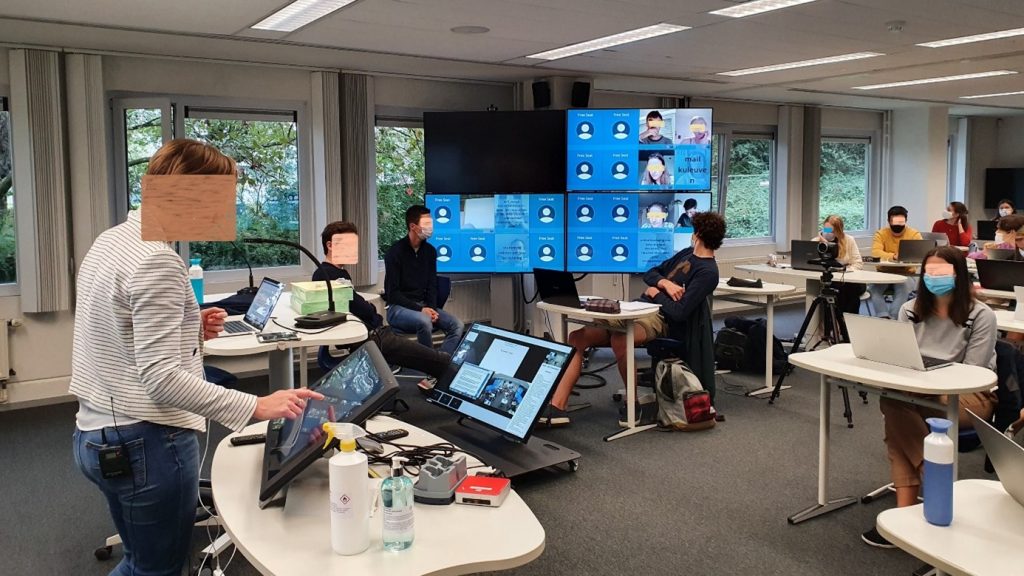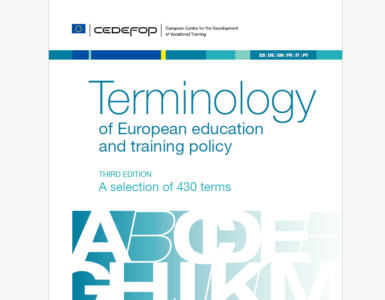by Annelies Raes, KU Leuven, Belgium & Université de Lille, France.
More and more voices claim that the nature and structure of future educational institutions will be hybrid to better deal with fast changing contexts and in order to accommodate the different needs of a diverse learner community.

As shown in the pictures, hybrid learning environments allow learners to attend synchronously online from home, work or when traveling while being connected with on-site students. The idea of hybrid education is not new in the field; over the last 15 years, new educational models have been proposed such as HyFlex learning and teaching conceptualized by Beatty (2007) and multi-access education conceptualized by Irvine et al. (2013).
Covid-19, however, has caused a surge, forcing every institution into a transition. Many institutions had to switch to what we call emergency teaching as they were not prepared for online models of learning.
While it is still premature to conclude on the impact of the COVID-19 pandemic on education and learning, it is possible through the many studies conducted in different countries to get a first glimpse of the students’ experience of online and hybrid education during this particular period. Results show that the forced transition to online and hybrid education led to a significant increase in academic workload which caused more stress for students (Yang et al., 2021). Moreover, although students found advantages in studying alone at home (e.g., time saved by not having to travel), they reported greater difficulty staying task-focused. They also had less opportunities to interact with their peers and experienced greater difficulty with working on group projects.
More than ever we realized that to promote a positive, engaging and optimal learning experience for both on-site and remote students, careful design is needed. Yet to be able to make thoughtful design decisions, empirical research is needed about how these new learning spaces are experienced by both students and teachers and to better understand how students are dealing with these new forms of delivery.

In my most recent paper, I aimed to fill this gap by both studying the learning and the teaching space through the lens of the Activity-Centred Analysis & Design framework (Goodyear et al., 2021). Regarding the student perspective, my research did not find any significant differences between the levels of presence (i.e. physical and remote presence) in terms of conceptual understanding, yet significant differences were found regarding affective engagement, including intrinsic motivation, relatedness, experienced pressure, cognitive absorption, autotelic experience, sense of presence and sense of belonging. These findings are in line with previous research claiming that on-site students and remote students experience courses differently in the hybrid synchronous situation (Beatty 2007, 2019; Szeto 2014; Zydney et al. 2019). Nevertheless, my study also provided both quantitative and qualitative evidence that the design of the learning space really does matter to the remote experience meaning that we cannot draw conclusions about the efficacy of hybrid education by just comparing the experiences of in-person and remote students without taking into account the design. Remote can be experienced very differently. Students following the course through livestream without interaction or visibility to the teachers had the lowest engagement scores. In line with this, several students stated that seeing the teachers and seeing each other really help them maintain closer connections. However, having an innovative infrastructure will not guarantee anything. Two-thirds of the students indicated that what a teacher is doing during the course (i.e. epistemic design, e.g. asking a lot of questions, contextualizing knowledge by telling an anecdote) and having the feeling that you are not alone (i.e. set design) are the most important for engendering engagement. Nonetheless, social design and epistemic design are closely interrelated with set design, as a certain teaching space can better support interaction and sense of belonging.
Also for teachers, their teaching space has drastically changed over the course of the past two years. The teachers in my study stated that they felt lucky to have experienced well-equipped teaching spaces as they believe that the spaces supported them in qualitative teaching, and they believe that the facilities of the new spaces serve to engage both staff and students. Yet, we should be realistic in the sense that not every space will have all the facilities included. Next, when having huge student groups, the livestream option will still be used in future education. In these settings it will be important to incorporate live engagement, e.g. through polls and/or quizzes, and create activate learning scenarios including activities on the individual, group and classroom level. This means that to design supportive hybrid learning and teaching it is crucial to take into consideration pedagogical, social and technical elements as being part of the epistemic, social and set design of a learning and teaching space.
Next to the importance of design, student choice is of particular interest in future hybrid education. In my future research I hope to gain better insight into the factors that affect student choice of course modality and learning environment (who attends where and when?). Moreover, I believe that it will be important to question to what extent students have the necessary skills and motivation to deal with the flexibility more and more institutions are offering.
| Some comments worth noting: Student: “Personally, what is determining for me, is feeling the ‘atmosphere’ in the auditorium, at home you cannot hear the conversation that is going on between your peers that are physically present at campus, that makes me feel excluded as a remote student.” Teacher: “I want to see it on their faces if they do not understand something” |

Author
Annelies Raes
Postdoctoral Researcher in Instructional Psychology and Technology, KU Leuven, Belgium and Université de Lille, France
This article is partly based on Annelies’ article in Postdigital Science and Education.
Editor’s note: We are delighted to have Annelies as one of our keynote speakers for the Media & Learning 2022 Conference on 2-3 June in Leuven, Belgium. She will be giving a talk entitled “Rethinking learning spaces in an uncertain world: Student and teacher experiences with hybrid teaching and learning at KU Leuven”
References
Beatty, B. J. (2007). Hybrid classes with flexible participation options – If you build it , how will they come? Paper presented at the 2007 Association for Educational Communications and Technology Annual Convention (October). Anaheim, CA: Association for Educational Communications and Technology.
Beatty, B. J. (2019). Hybrid-Flexible Course Design: Implementing student-directed hybrid classes. EdTech Books. https://edtechbooks.org/hyflex
Goodyear, P., Carvalho, L., & Yeoman, P. (2021). Activity-Centred Analysis and Design (ACAD): Core purposes, distinctive qualities and current developments. Educational Technology Research and Development, 0123456789. https://doi.org/10.1007/s11423-020-09926-7.
Irvine, V., Code, J., & Richards, L. (2013). Realigning Higher Education for the 21st-Century Learner through Multi-Access Learning. Journal of Online Learning and Teaching, 9(2). https://jolt.merlot.org/vol9no2/irvine_0613.pdf
Yang C, Chen A, Chen Y (2021) College students’ stress and health in the COVID-19 pandemic: The role of academic workload, separation from school, and fears of contagion. PLoS ONE 16(2). https://doi.org/10.1371/journal.pone.0246676
Szeto, E. (2014). A Comparison of Online/Face-to-face Students’ and Instructor’s Experiences: Examining Blended Synchronous Learning Effects. Procedia – Social and Behavioral Sciences, 116, 4250–4254. https://doi.org/10.1016/j.sbspro.2014.01.926.
Zydney, J. M., McKimm, P., Lindberg, R., & Schmidt, M. (2019). Here or There Instruction: Lessons Learned in Implementing Innovative Approaches to Blended Synchronous Learning. TECHTRENDS, 63(2), 123–132. https://doi.org/10.1007/s11528-018-0344-z.














